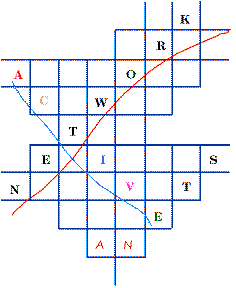An Active Solution to Adaptive Routing
|
 |
"The
effect of good routing is to increase throughput for the same value of
average delay per packet under high offered load conditions and to decrease
average delay per packet under low and moderate offered load conditions."
(D. Bartsekas, R. Gallager, Data Networks)
Adaptive
Routing algorithms attemp to change their routing decisions to reflect
changes in topology and the current traffic.
Congestion
is one of the main factors that prevent current networks from reaching
an optimal throughput.
The
problem is not so much in the algorithms of flow control, but rather in
the net itself, which is not cooperative, so it is clear that Active
Networks may provide a powerful tool to address this issue.
Our
protocol is not intended to solve the entire problem, rather it just aims
to provide a useful service to upper level protocols, through the use of
Distributed
Artificial Intelligence techniques.
The Project
The
algorithm is based on previous studies about cooperative learning
and artificial life; in particular the focus is on some aspects
of the behaviour of ants in nature. Though very simple insects, ants are
able to find optimal paths between the nest and the food source by just
reacting to local stimuli; the global effectiveness arises from an environment-based
communication (stigmergy) developed through evolution. They release
a substance called pheromone as they follow a route and, since they
are also influenced by the presence of pheromone in the choice of a new
path, the overall effect is that routes that were chosen by a great number
of ants will become more and more attractive to subsequent ants, whereas
unpromising paths will be discarded. In other words this is reinforcement
learning or, in other words, positive feedback.
Basically,
if the ants take into account the appropriate parameters when releasing
their pheromone, the result is a routing whose metric is congestion, but
the approach is quite different from the traditional one:
-
it is
completely distributed: there is no need for a central authority
to manage the ants; moreover it is not important if a single ants dies
or gets lost, since it is the global behaviour that we are interested in,
so the algorithm is also robust;
-
it is
adaptive:
when a link goes down or another becomes available, ants will simply explore
the new possibilities;
-
ants are
small so they don't waste a big deal of bandwidth, which is particularly
desirable in a congested environment.
All
of these features make ants particularly suitable to be implemented in
an active environment.
Further developments
Future
experiments will be focused on the effects of using new metrics for the
choice of the best path. Analysis will not be limited to dynamic metrics,
but will also cover static ones and in particular we would like to test
the performance resulting from a combination of both kinds of metrics.
In
a wider range of time we would also like to examine the possibilities deriving
by a multipath strategy routing, which entails a somehow more
complex
class of issues.
In
order to make it easier to carry on with network experiments, it is currently
on development a graphical tool, to set
up and monitor a network of active nodes, with the possibility of modifying
the behavior of the nodes on the fly.
People
Staff
Giuseppe
Di Fatta
References
M. Dorigo, V. Maniezzo,
A. Colorni, "Positive Feedback as a Search Strategy", Technical Report
No. 91-016, Politecnico di Milano, Italy, 1991. (gzipped
postscript file)
G. Di Caro, M. Dorigo,
Mobile
Agents for Adaptive Routing, Proceedings of the 31st Hawaii International
Conference on System, IEEE Computer Society Press, Los Alamitos, CA, 74-83.
Also available as Tec.Rep.IRIDIA/97-20, Université Libre de Bruxelles,
Belgium, 1998. (gzipped
postscript file)
S. N. Willmott, B.
Faltings, Active Organisations for Routing, Proceedings of the First
International Working Conference on Active Networks, pages 262-273. Editor
S. Covaci. Springer Verlag, Lecture Notes in Computer Science Series, number
1653. July 1999. (postcript
file)
Publications
G. Di Fatta, S. Gaglio, G. Lo Re, M. Ortolani,
Adaptive
Routing in Active Networks, Proceedings of OpenArch 2000. IEEE Third
Conference on Open Architecture and Network Programming. Tel Aviv, March
2000. (gzipped postscipt file)
G. Di Fatta, S. Gaglio, G. Lo Re, M. Ortolani,
Artificial
Ants for Active Routing, IAS6, the 6th International Conference on
Intelligent Autonomous Systems. Venice, July 2000. (gzipped
postscript file)
last
update 2 October 2000

